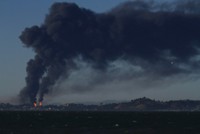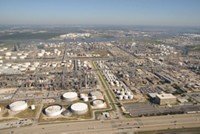Advertisement
Grab your lab coat. Let's get started
Welcome!
Welcome!
Create an account below to get 6 C&EN articles per month, receive newsletters and more - all free.
It seems this is your first time logging in online. Please enter the following information to continue.
As an ACS member you automatically get access to this site. All we need is few more details to create your reading experience.
Not you? Sign in with a different account.
Not you? Sign in with a different account.
ERROR 1
ERROR 1
ERROR 2
ERROR 2
ERROR 2
ERROR 2
ERROR 2
Password and Confirm password must match.
If you have an ACS member number, please enter it here so we can link this account to your membership. (optional)
ERROR 2
ACS values your privacy. By submitting your information, you are gaining access to C&EN and subscribing to our weekly newsletter. We use the information you provide to make your reading experience better, and we will never sell your data to third party members.
Safety
Beefing Up Refinery Regulations
Safety: California panel calls for inherently safer systems
by Jeff Johnson
February 24, 2014
| A version of this story appeared in
Volume 92, Issue 8

A state panel is calling for a major overhaul of California refinery regulations in the wake of a 2012 explosion and fire at Chevron’s refinery in Richmond, Calif. The incident prompted thousands of nearby residents to seek medical treatment.
After an 18-month review, the Interagency Working Group on Refinery Safety is recommending improvements in emergency response, accident prevention and investigations, and workplace safety. California Gov. Jerry Brown (D) created the panel, which consists of representatives from 13 key state agencies, shortly after the 2012 accident. The group aims to improve worker and community safety through better oversight of the state’s 15 major petrochemical refineries.
The panel’s recommendations appear to respond to the immediate cause of the Chevron accident—a ruptured, badly corroded pipe that the company knew about for a decade but did not replace. The explosion and resulting fire burned for hours and sent some 15,000 Richmond residents to hospitals.
The working group urges refineries to implement inherently safer systems, as well as to conduct periodic assessments of their safety culture. Likewise, the U.S. Chemical Safety & Hazard Investigation Board’s report on the Chevron incident also underscored that inherently safer approaches would have at a minimum required replacement of the corroded pipe.
But inherently safer system requirements have long been a bugaboo for industry and earned the ire of U.S. industry associations. In a Jan. 23 letter to President Barack Obama, 13 business groups, including the American Petroleum Institute and the American Chemistry Council, said they strongly oppose mandates “to assess or implement so-called inherently safer technologies.”
They were responding to proposals under consideration by an accident-related working group appointed by Obama that is also seeking to improve chemical plant safety. Another industrial disaster, which occurred at West, Texas, in April 2013, triggered the creation of the federal working group.
California’s next step will be putting the recommendations into effect. Brown has created a task force made up of representatives from state and local enforcement offices and the U.S. Environmental Protection Agency to oversee implementation.




Join the conversation
Contact the reporter
Submit a Letter to the Editor for publication
Engage with us on Twitter